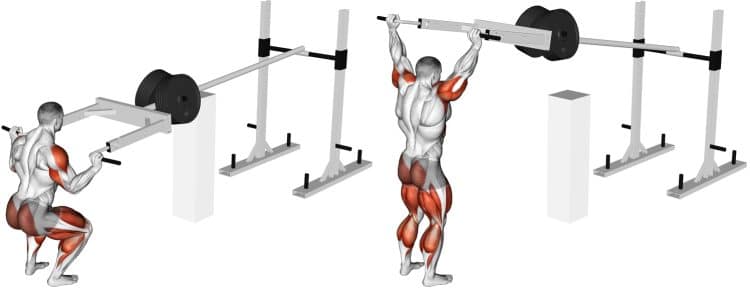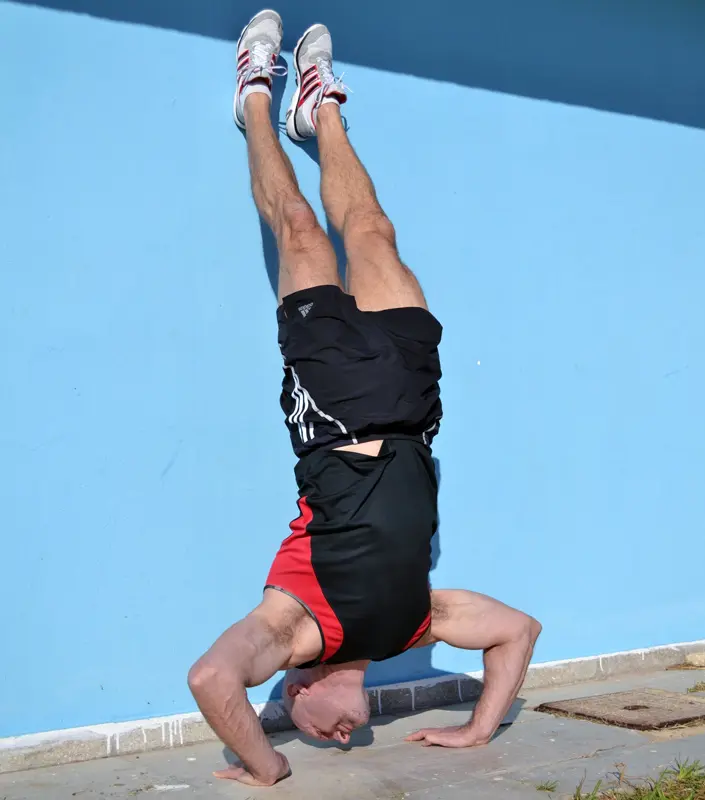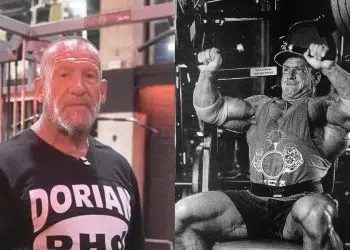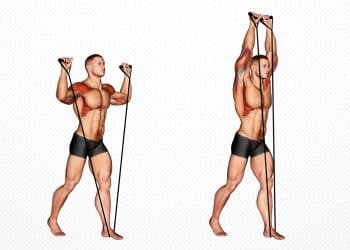The Viking press is an exercise that often features in strongman competitions. It’s also gaining popularity in other strength training circles, and an increasing number of gyms have a Viking press machine.
In competition, the Viking press is typically done for reps, but some events include maximum weight for a single rep.
In simple terms, a Viking press apparatus is a handle attached to a straight lever. The lever extends to a fulcrum which is typically positioned at chest height. However, there are also Viking press attachments for landmines, which place the pivot point on the floor.
The handles move in a slight arc and not straight up, as they tend to do with regular shoulder press machines. Most Viking presses feature a neutral or parallel grip, making this a very shoulder-friendly pressing exercise.
In this article, we take a closer look at the Viking press, explaining why and how to do it, and reveal some of the best variations and alternatives.
Viking Press Muscles Worked
The Viking press is a compound exercise, which means it involves several muscles and joints working together. In addition, lifters are allowed to use their legs to initiate each rep, which means the Viking press is virtually a full-body exercise.
Level Up Your Fitness: Join our 💪 strong community in Fitness Volt Newsletter. Get daily inspiration, expert-backed workouts, nutrition tips, the latest in strength sports, and the support you need to reach your goals. Subscribe for free!

The main muscles involved in Viking presses are:
Deltoids – at its core, the Viking press is a shoulder pressing exercise. It involves all three deltoid heads: anterior, medial, and posterior. That said, it’s the anterior deltoid that’s most active, and the other two deltoids are working more as stabilizers.
Triceps – if you don’t lock out your Viking press rep, it doesn’t count. As such, this exercise tests and builds your triceps, which is the muscle located on the back of your upper arm. If you want thicker triceps, the Viking press could help.
Legs – unless you are doing strict Viking presses and keeping your legs completely straight, every rep starts with a knee dip and drive to get the weight moving. This allows lifters to use more weight or complete more reps.
As such, Viking presses involve your lower body muscles, including the quadriceps, hamstrings, and glutes. However, the range of motion and time under tension is very small, so doing Viking presses probably won’t make your legs much bigger or stronger.
Core – you’ll need to stabilize your spine to transmit the forces generated by your legs up your body and into your arms so you can press the weight overhead. Your core muscles brace your midsection to prevent it from collapsing.
The core is the collective term for your rectus abdominis, obliques, transverse abdominus, and erector spinae. Viking presses involve a lot of core engagement. These muscles contract inward to increase intra-abdominal pressure, acting much like a natural weightlifting belt.
How to Do Viking Presses
Get more from Viking presses while keeping your risk of injury to a minimum by following these guidelines:
- Adjust the height of the handles so that they’re just below shoulder height. Grip the handles with your hands facing inward, i.e., a neutral grip. Wrap your thumbs around the bar, or use a thumbless grip as preferred.
- Depending on the apparatus you’re using, you may face toward or away from the weight.
- Position yourself between the handles and stand with your feet shoulder-width apart. Brace your core.
- Use your legs to lift the weight clear of the supports.
- Bend your knees slightly and then explosively extend your legs. Use this momentum to help you press the weight up and overhead. Push your head forward and between your arms to help drive the weight up.
- Do not re-bend your knees after the initial press as, in a strongman competition, that would result in a no-lift.
- Lower the bar back down and repeat.
- You can also do the Viking press without using your legs.
Viking Press Benefits and Drawbacks
Not sure if Viking presses are the right exercise for you? Consider these benefits:
Very shoulder and wrist-friendly – the Viking press features a neutral or parallel grip. Compared to pressing a barbell overhead, where your palms face forward, this is a shoulder-friendly position. If regular overhead presses cause wrist or shoulder pain, you may find Viking presses more comfortable.
There is no need to clean heavy weights to your shoulders – most Viking press machines allow you to start each rep at shoulder height, with no need to lift the weight from the floor before you start. This means you won’t have to waste your energy on power cleaning the bar up to begin your set and can put all your effort into working your shoulders.
A full-body exercise – done with a leg dip and drive, the Viking press works all of your major muscles, from your legs to your triceps and everything in between. Short on time but still want a comprehensive workout? The Viking press and some pull-ups will get the job done!
Very functional – the Viking press trains your body as it works in nature; as a single, synergistic unit. Using your arms, legs, and core simultaneously is the most effective way to lift heavy weights above your head. As such, Viking presses are a very functional exercise and could benefit athletes from most sports as well as people looking to develop strength they can use outside the gym.
A safe exercise – the neutral grip and raised starting/finishing position mean that you won’t get crushed by a heavy weight if you cannot complete a rep. Instead, you can just lower the bar and walk away. This means that Viking presses are ideal for solo trainers and potentially safer than barbell and dumbbell overhead presses.
While Viking presses are a mostly beneficial exercise, there are also a few drawbacks to consider:
Availability – the biggest drawback with Viking presses is that very few gyms have one. It’s a specialized machine that’s mostly found in strongman training facilities. That said, you can use a landmine handle attachment, and there are other ways you can recreate this exercise, which we’ve detailed below.
On the downside, using a landmine means you’ll need to lift the handle up to your shoulders from the floor. This could be awkward and even dangerous if you are training with heavy weights.
Lower back stress – in an effort to press more weight, a lot of lifters lean back so they can increase pec engagement, turning the Viking press into a sort-of incline bench press. While this may mean more reps or heavier weights, it’s a potentially dangerous maneuver that could lead to lower back pain and injury.
However, when you’re a professional strongman, scoring one more rep could be the difference between winning and losing, so that’s a risk you may have to accept!
Level Up Your Fitness: Join our 💪 strong community in Fitness Volt Newsletter. Get daily inspiration, expert-backed workouts, nutrition tips, the latest in strength sports, and the support you need to reach your goals. Subscribe for free!
8 Viking Press Variations and Alternatives
Viking presses are a highly effective shoulder exercise, but that doesn’t mean you need to do them all the time. They may even be impossible if your gym doesn’t have a Viking press machine.
The good news is that there are several variations and alternatives you can use to keep your shoulder workouts productive and interesting:
1. Double barbell Viking press
No Viking press machine? No problem! You can rig up a very similar exercise using a power rack and two barbells.
How to do it:
- Set the safety bars in a power rack to just below shoulder height. Place two barbells across the safety bars.
- Put two weight plates on one end of each bar so that the safety bars are clamped between them. This will stop the bars from slipping when you lift them.
- Standing at the opposite end, grab the bars with a neutral grip, hands slightly wider than shoulder-width apart.
- Perform your Viking presses as usual, taking care not to bounce the bars off the power rack safety rods.
2. Neutral grip dumbbell shoulder press
One of the best things about the Viking press is that your hands face inward in a neutral grip, which takes stress off your shoulders and elbows. You can use this same grip for standing dumbbell presses, with or without using leg drive to push the weights up and overhead.
How to do it:
- Hold a dumbbell in each hand and stand with your feet shoulder-width apart, core braced.
- Raise and hold your dumbbells at shoulder height, palms facing inward. The weights should be just in front of your shoulders and your forearms vertical.
- Either keeping your legs straight or with a dip of your knees for assistance, press the weights up and overhead.
- Lower the dumbbells back to your shoulders and repeat.
- You can also do this exercise using kettlebells.
3. Push-press
The push-press uses all of the same muscles as the Viking press but is a much more accessible exercise, as all you need is a barbell or dumbbells. That said, for ease, do barbell push-presses from a squat or power rack to save you having to clean the bar to your shoulders at the start of each rep. However, if you use dumbbells, you’ll need to start each set with a power clean.
Learn how to do push-presses here.
4. Javelin press
The Javelin press is a very unusual neutral grip overhead pressing exercise. Because it’s a unilateral or one-sided exercise, it’s good for developing balance and core strength. This exercise will teach you to stabilize your entire body, which should have a positive impact on your Viking press performance.
How to do it:
- Place your barbell in a shoulder-height squat rack. Stand sideways onto the bar and grip the center using a neutral grip. Brace your abs and unrack the bar.
- Keeping your hips and shoulders level, press the weight up and overhead to arms’ length. Do not allow the bar to turn or tilt.
- Lower the bar back to your shoulder and repeat.
- Rerack the bar and then swap sides.
5. Z press
The Z press is named after legendary strongman Zydrunas Savickas and, like the Viking press, is another challenging shoulder exercise. While not a competitive strongman event, the Z press will develop your core, shoulders, and triceps so you can Viking press more weight.
How to do it:
- Between the uprights of a squat rack, sit on the floor with your legs straight and spread wide for balance. Place a barbell on the J-hooks at about shoulder height. Sit up tall, brace your abs, and hold the bar with an overhand, slightly wider than shoulder-width grip.
- With your core tight and shoulders down and back, unrack the bar and hold it across your shoulders as you would for regular overhead presses. Do not lean forward or back. Lift your chest.
- Keeping your core tight, press the bar up and overhead.
- Lower the bar back to your shoulders and repeat.
- Focus on maintaining a good upright posture and tight core throughout. Do not allow your lower back to round, so no slouching!
- You can also do the Z press with two dumbbells or kettlebells or by lifting one weight at a time.
Read more about the Z press here.
6. Shoulder press machine
While you won’t be able to use your legs for this Viking press alternative, you should be able to adopt a neutral grip. Plus, with your back supported, you can focus 100% on pressing the weight up and overhead. This is a good Viking press alternative for beginners, or anyone more interested in increasing should mass than strength.
How to do it:
- Adjust the seat so that your shoulders are level with the handles. Sit on the machine and grab the handgrips.
- Press the weights up and overhead to arms’ length. Do not lock your elbows.
- Lower the weights back down but do not allow them to touch.
- Most machines have parallel and straight handles. Use the parallel ones to most closely mimic the demands of the Viking press.
7. Trap bar overhead press
While trap bars are most commonly associated with lower body training, you can use one to mimic Viking presses, too. Place your trap bar in a power rack set to shoulder height and stand between the handles. With your core braced, press the bar up and overhead to arms’ length.
You can do trap bar overhead presses with or without your legs as preferred.
8. Handstand push-ups
Not having a Viking press is a difficult barrier to overcome. Still, there are plenty of barbell, dumbbell, and machine exercises you can do instead. But, what if you’re stranded on a desert island with no training equipment at all?
Don’t worry; you can beef up your deltoids and triceps using just your body weight. Just kick your feet up against a tree and do some handstand push-ups to train the same muscles as Viking presses.

How to do it:
- Squat down and place your hands about 12” away from a smooth wall. Your hands should be slightly wider than shoulder-width apart, fingers pointing forward.
- Kick yourself up into a handstand position and rest your feet against the wall. Brace your abs and look down toward the floor.
- Bend your arms and lower your forehead down to the floor. Descend slowly to avoid banging your head.
- Extend your arms and press yourself back up.
- Make this exercise harder by placing your hands on blocks to increase your range of motion.
Viking Press – Wrapping Up
The Viking press is a blue-ribband event in many strongman competitions. In fact, it was the Viking press that all but decided the 2017 WSM title between Eddie Hall and Hafthor Bjornsson and seemingly triggered their feud and upcoming boxing match.
Regardless of whether you’re an aspiring strongman or just want a new exercise to build bigger, stronger deltoids and triceps, the Viking press is a great choice. However, unless you train in a very well-equipped gym, you may not have access to the necessary machinery to do it.
Remember, though, you can simulate this exercise using two barbells and a power rack or a landmine and Viking press handle attachment. There are also several equally effective alternatives you can do instead.
Either way, if you want more muscular, stronger shoulders, make sure that variations of the overhead press are a big part of your upper body workouts.
Interested in measuring your progress? Check out our strength standards for Bench Press, Push Ups, Pull Ups, and more.









Where can I buy that Viking press attachment?
It depends on where you live but there are LOADS on Amazon – this one can be used with a conventional barbell and includes a landmine pivot plate.
https://a.co/d/0eyRo07